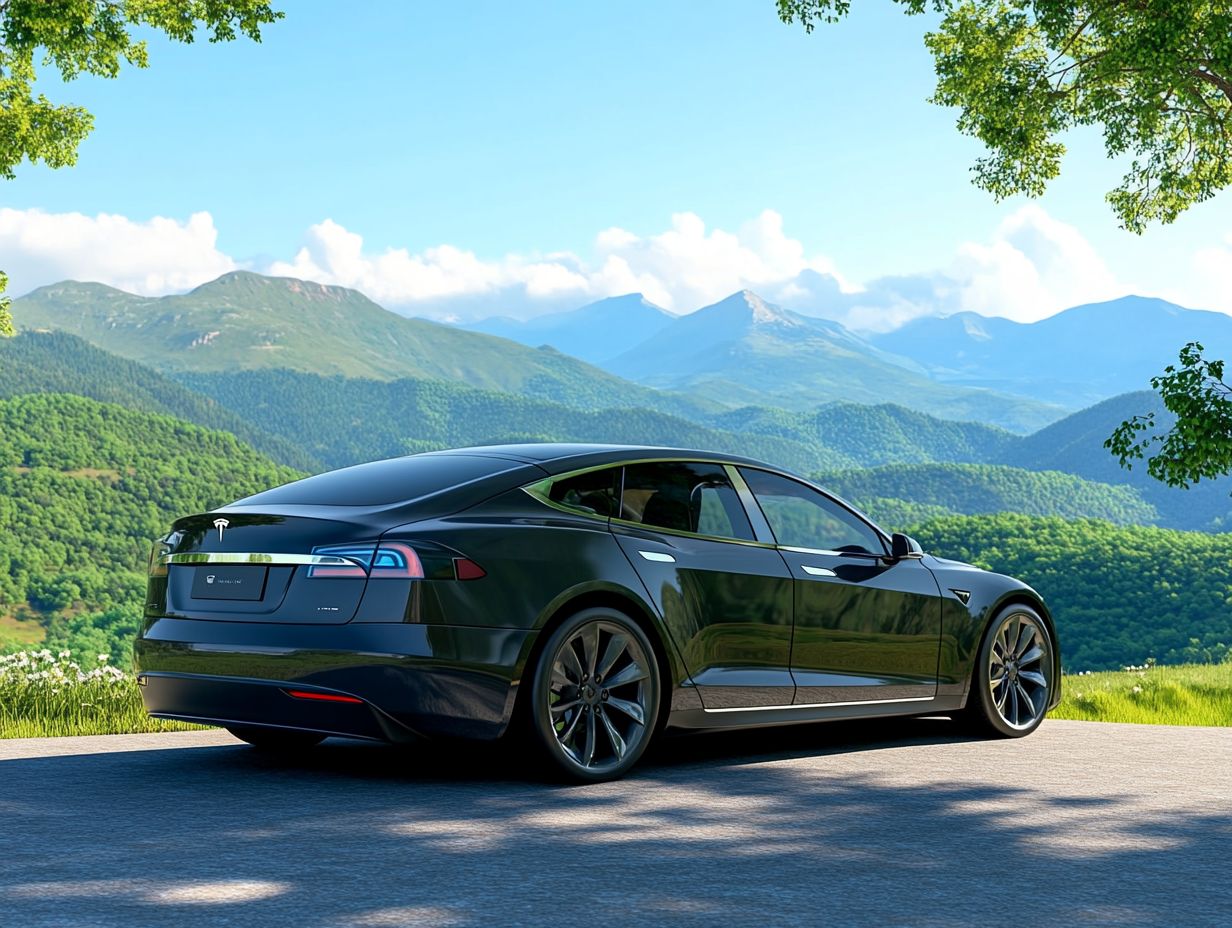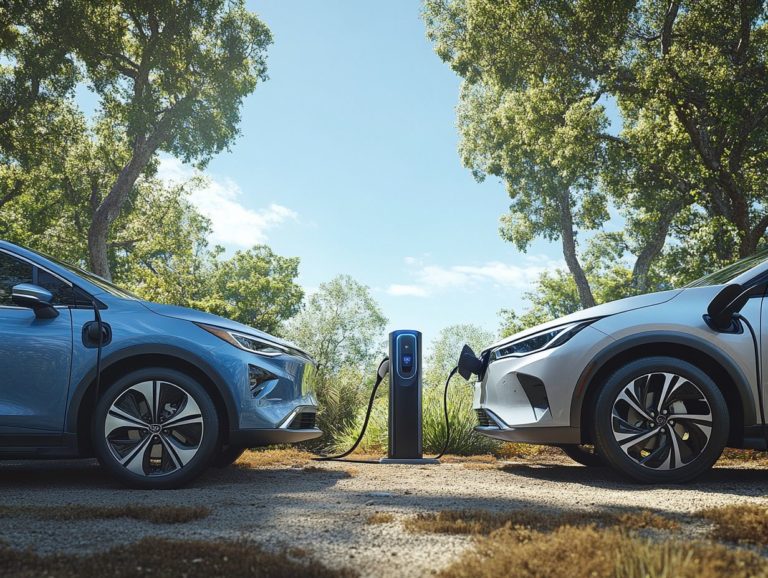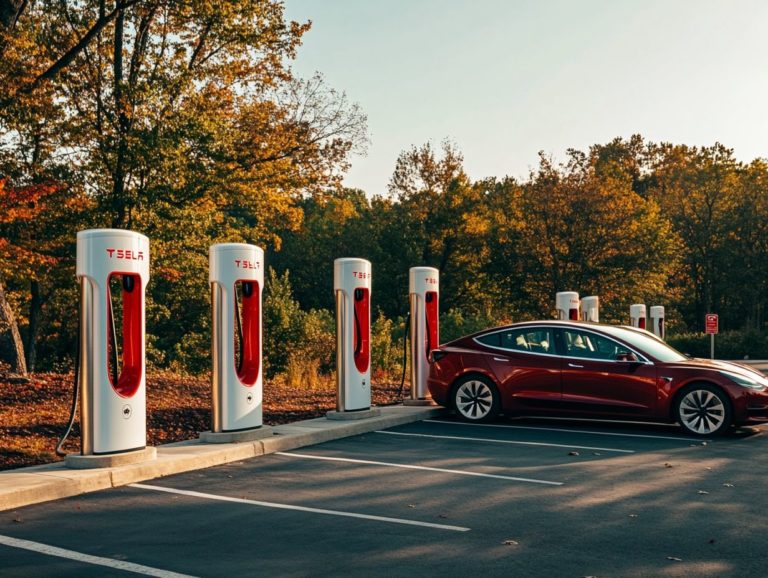7. understanding range-extended electric vehicles
As the automotive industry embraces greener technologies, you ll find that Range-Extended Electric Vehicles (REEVs) are capturing attention with their exceptional combination of electric efficiency and extended range capabilities. Curious if a REEV is right for you?
This overview delves into the definition and functionality of REEVs, exploring their operational mechanics while highlighting a plethora of benefits from environmental advantages to significant cost savings.
You ll also uncover the challenges these vehicles face, discover popular models available today, and consider the future prospects that could revolutionize your driving experience. Dive in to unveil how REEVs could very well be the key to a more sustainable automotive future!
Contents
- Key Takeaways:
- What are Range-Extended Electric Vehicles (REEVs)?
- How do REEVs Work?
- Benefits of REEVs
- Challenges and Limitations
- Popular Models of REEVs
- Future of REEVs
- Frequently Asked Questions
- What is a range-extended electric vehicle (REEV)?
- How does a range-extended electric vehicle differ from a traditional hybrid vehicle?
- What advantages does a range-extended electric vehicle offer?
- Are there any downsides to owning a range-extended electric vehicle?
- Can a range-extended electric vehicle be charged at home?
- Are there any tax incentives for purchasing a range-extended electric vehicle?
Key Takeaways:

Range-Extended Electric Vehicles (REEVs) combine the benefits of electric and traditional cars, offering an extended driving range while also supporting environmental sustainability. For more insights, check out understanding electric vehicle range: a buyer’s guide.
REEVs use a combination of electric motors and a gasoline-powered generator to charge the battery, allowing for longer distances and reducing the need for frequent charging.
The future of REEVs looks promising, with advancements in technology and potential cost savings making them a viable option for both consumers and the automotive industry.
What are Range-Extended Electric Vehicles (REEVs)?
Range-Extended Electric Vehicles (REEVs) are a remarkable innovation, seamlessly merging the advantages of electric cars with the reassurance of a backup gasoline engine.
Unlike traditional electric vehicles that depend solely on battery power, REEVs utilize an Extended Range Electric Vehicle (EREV) configuration, enabling efficient operation over longer distances and alleviating concerns about running out of battery.
This hybrid functionality grants you the flexibility you need, especially in areas where charging infrastructure is still catching up. As manufacturers focus on refining the electric powertrain, REEVs present an enticing alternative in today s dynamic market.
Definition and Functionality
Range-Extended Electric Vehicles (REEVs) are expertly crafted to harness both battery power and a gasoline engine, allowing you to enjoy an extended electric-only range. To learn more about maximizing this capability, check out how to extend the range of your electric car without sacrificing driving performance.
This innovative approach strikes an impressive balance between efficiency and practicality.
By seamlessly integrating electric motors with a gasoline-powered range extender, these vehicles lessen reliance on fossil fuels and significantly curtail harmful emissions.
Think of the range extender as your trusty safety net, ensuring you maintain your freedom on longer journeys by providing that extra power when battery levels dip.
As a result, you can relish the advantages of electric driving for your daily commutes while having the flexibility to embark on extended trips, free from the anxiety often linked to battery-only options.
How do REEVs Work?
REEVs utilize a sophisticated electric powertrain that seamlessly blends electric-only driving with the support of a gasoline generator.
This innovative system ensures optimal performance under various conditions, delivering both efficiency and versatility.
Overview of the Technology
The technology behind REEVs integrates advanced battery systems and electric powertrains, positioning these vehicles as the ideal bridge between traditional combustion engines and fully electric options.
Recent advancements in battery technology have been instrumental in enhancing performance and efficiency. Batteries known for their high energy capacity, such as lithium-ion batteries, provide longer ranges on a single charge.
Sodium-ion batteries also offer a promising alternative that could lower costs and decrease reliance on rare materials.
These innovations elevate the vehicle’s power and responsiveness while enhancing regenerative braking systems, enabling the recapture of energy to extend your driving range even further.
As a result, you can revel in a sustainable and efficient driving experience without compromising performance.
Benefits of REEVs

REEVs offer amazing benefits that you ll love!
- Substantial environmental benefits
- Impressive cost savings
- Elevated driving experience
These advantages position them as an enticing choice for a diverse array of consumers. Don t miss out on this innovative driving experience!
Environmental and Cost Savings
One of the most compelling reasons to consider REEVs is their potential for lower emissions and improved fuel efficiency compared to conventional gasoline-powered vehicles.
With the growing urgency around combating climate change, these vehicles significantly reduce greenhouse gas emissions, contributing to cleaner air and a healthier environment.
Operating on a blend of electric power and smaller internal combustion engines, their efficiency reduces reliance on fossil fuels. This dual approach cuts down on harmful pollutants and translates into considerable cost savings for you as an owner.
In the long run, fuel and maintenance costs are often lower than those of traditional vehicles, making REEVs a financially savvy and eco-friendly choice for discerning drivers.
Challenges and Limitations
Despite their numerous advantages, REEVs present several challenges and limitations you should be aware of.
Concerns include inadequate charging infrastructure, confusion among consumers about various vehicle types, and the worry about how far you can drive on a single charge.
Current Limitations and Potential Solutions
The current limitations of REEVs include inadequate charging infrastructure and a lack of consumer awareness, which hinder their widespread adoption in the EV market. These barriers may discourage you from considering REEVs as a viable alternative to traditional vehicles.
Manufacturers could collaborate with local governments and private stakeholders to expand charging networks, ensuring they are conveniently located and easily accessible for you.
Enhancing consumer education initiatives through informative campaigns and interactive workshops can significantly elevate your awareness and perception of REEV technology. Showcasing the benefits and advancements in this sector can foster your confidence as a potential buyer, ultimately driving market growth and promoting wider acceptance of electrified transportation solutions.
Popular Models of REEVs
Several popular models of Range-Extended Electric Vehicles (REEVs), such as the Chevrolet Volt, BMW i3, and Ford Fusion Energi, exemplify the remarkable diversity and innovation in this burgeoning vehicle segment.
Comparison and Features

When comparing popular models of REEVs, features like driving performance, battery capacity, and overall user experience stand out as key differentiators. Each model captures a unique segment of the market, underscoring the importance of understanding what you value most.
If you prioritize swift acceleration and smooth handling, performance becomes your focal point. Conversely, if an impressive battery range is essential for your daily commutes, that will be your primary concern.
The integration of advanced technology like systems that combine entertainment and information features in your car enhances your overall driving experience, especially if you consider yourself tech-savvy.
As these features evolve, manufacturers are diligently working to satisfy your demands for efficiency and innovation. This dynamic landscape shapes the future of electric vehicles, ensuring that your needs remain at the forefront of design and functionality.
Future of REEVs
The future of REEVs is incredibly exciting, with innovations on the horizon that will enhance your driving experience and integration within the automotive industry.
As these advancements unfold, expect a transformative shift in how REEVs fit into your life, making them more attractive and accessible than ever before.
Advancements and Potential Impact on the Automotive Industry
Improvements in battery technology, electric engines, and charging speed are poised to redefine the role of REEVs in the automotive landscape. These innovations offer better fuel efficiency and driving performance, making REEVs an increasingly appealing option for you as a consumer.
With longer ranges and quicker charge times, you may find the practicality of these vehicles becoming more attractive. This may prompt you to reconsider your choices. As manufacturers continue to integrate cutting-edge materials and smart energy management systems, get ready for exciting changes in the market!
This transformation could lead to a surge in demand, compelling automakers to prioritize and innovate in this segment. Ultimately, this will benefit both the environment and your driving experience.
Frequently Asked Questions
What is a range-extended electric vehicle (REEV)?
A range-extended electric vehicle, also known as a plug-in hybrid electric vehicle (PHEV), is a type of vehicle that combines an electric motor with a gasoline engine. This lets the vehicle use electricity, gasoline, or both, depending on what you need.
How does a range-extended electric vehicle differ from a traditional hybrid vehicle?
Unlike a traditional hybrid vehicle, which primarily uses its gasoline engine and only uses its electric motor for short periods, a range-extended electric vehicle can run on electricity for longer distances before switching to its gasoline engine. This makes it a more efficient and environmentally friendly option.
What advantages does a range-extended electric vehicle offer?
- Lower fuel costs
- Increased fuel efficiency
- Reduced emissions
- Flexibility to switch between electric and gasoline power
These vehicles are ideal for longer trips.
Are there any downsides to owning a range-extended electric vehicle?
A downside to consider is that range-extended electric vehicles often have a higher initial price tag compared to traditional gasoline vehicles. However, the fuel savings over time can help offset this initial cost. Additionally, these vehicles may not be as widely available as traditional gasoline vehicles in some areas.
Can a range-extended electric vehicle be charged at home?
Yes, range-extended electric vehicles can be charged at home using a standard wall outlet or a dedicated charging station. This allows owners to conveniently recharge their vehicle overnight, reducing the need for frequent trips to a gas station.
Are there any tax incentives for purchasing a range-extended electric vehicle?
Yes, many governments offer tax incentives for purchasing environmentally friendly vehicles, including range-extended electric vehicles. These incentives can help reduce the overall cost of owning a range-extended electric vehicle.






